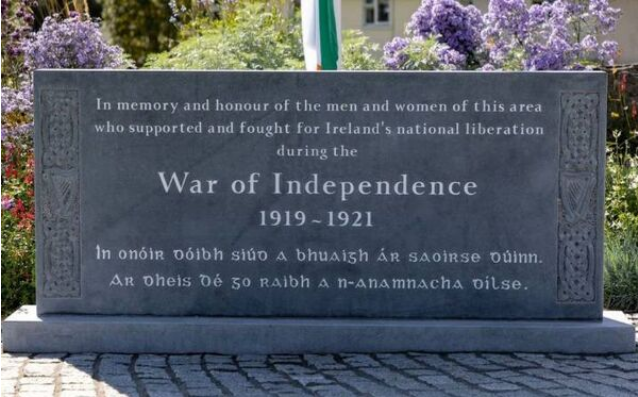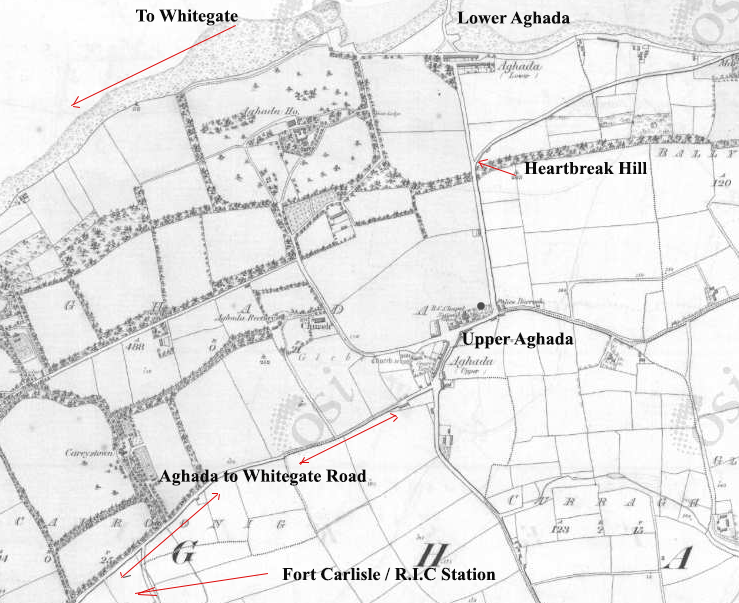Saleen Ambush

Folklore meets Realism
The Irish War of Independence was a conflict that took place from 1919 to 1921 between Irish nationalists seeking independence from Britain and British forces. The Irish Republican Army (IRA) led a guerrilla campaign against the British, employing tactics such as ambushes and attacks on military personnel and infrastructure. Throughout the war, various ambushes were carried out by IRA units across Ireland. Ambushes were a common tactic used by the IRA to target and disrupt British forces, often taking place on roads or other strategic locations. These ambushes aimed to seize weapons and ammunition from the British, gather intelligence, and create a sense of insecurity among the British forces. The village of Saleen and its surrounding landscape came under Aghada L Company and was part of three sections Aghada (33 volunteers), Ballinrostic (23 volunteers) and Saleen (23 volunteers).
Urban Legends are a popular form of modern folklore in today’s society. They are often intriguing tales of woe and corporate misdeeds with appalling details that excite - and sometimes incite- their audience. While often containing just a shred of truth, or perhaps none at all, they are generally accepted as factual and enjoy rapid dissemination. Having relied upon word-of-mouth in the past, in today’s electronic age there are varied methods of instant communication, enabling a wider audience to be reached. These legends are often embellished and tailored to fit a particular region or situation. Looked at with a bit of scepticism, legends allow one to identify tell-tale signs that a legend is not true – at least not completely as communicated.
Cantrell, M.D. (2010) Urban legends: Why do people believe them? Thesis. Wake Forest University.
On the 19 September 2021 the community of Saleen, which lies on the R630 regional road between Midleton and Whitegate had gathered for the official launch of its War of Independence Monument in honour of the men and women of the area, who fought for and supported Ireland’s freedom during the War of Independence. The War of Independence monument in Saleen was unveiled and the Irish flag flown over it for the first time. What I find intriguing is one of the foundations of the monument is based on an ambush that apparently happened during this period and a short distance away from this fine monument.
“Our local volunteers also initiated their own armed actions, an example of this was when Con McSwiney and others successfully ambushed British forces just up the hill there in Scartleigh.”
In the Brigade Activity Report MA/MSPC/A/1(10) it stated the following,
“it was one of the most pro-British areas in the South of Ireland. The Company covered an area of approximately 8 square miles. A large majority of the inhabitants of the Company area were hostile, being largely made up of Protestant Landowners and 7 seaside villages. Practically every house in those villages were occupied by British Army and Naval Pensioners and at least 80% of them were hostile. In the early stages before the Company were active a considerable quantity of arms and ammunition was handed in to Fort Carlisle by those ex-servicemen, which was later discovered when the Company had to raid at least 70% of the houses in the Area”.
The Heroes from Saleen
Young Con McSwiney vowed to free Mick Foley from the Tans.
With Billy Power advising him, they carefully made their plans.
The Crossley tender was attacked on the hill above Scartleigh,
And the Tans- they got a tanning - while the prisoner got away.
Fitzpatrick, B. (2021) ‘The Heroes from Saleen’, in Rebel Aghada, 1798-1923: The untold history of an east cork parish. Maynooth, Co. Kildare, Ireland: Iontas Press.
There is however an incident recorded in the Brigade Activity Report MA/MSPC/A/1(10), Index to Major Engagements (index I) which states Ambush of Military at Saleen March 1921. But it also states Ambush at Aghada in March 1921 (index H) in which the actual date of this event was 5 April 1921 and this too is highly questionable to its location as the Brigade Activity Report MA/MSPC/A/1(10) states no location of this ambush on “Aghada” but official documents state the following,
"Plain cloths patrol of Police men and Cameron’s fired on from behind walls on the Aghada – Whitegate road. The fire was returned and the attackers bombed. Military Operations and Inquiries"
WO 35/89 1920-1922
This statement would seem to question the ambush at Heartbreak Hill as this hill links the villages of Upper and Lower Aghada and not the Aghada – Whitegate road.

There is a possibility if not more than likely that the author for the Aghada Company records (Brigade Activity Report MA/MSPC/A/1(10) may have misinterpreted the ambush at Saleen with an event that occurred during the Civil War on 27 August 1922. These records were recorded a number of years (Mid to late 1930’s) after the War of Independence / Civil War.
There are a number of key factors that come into question. There are no records regarding the Ambush in Saleen during the War of Independence. Other factors I have taken into account and probably the biggest question of all is the date of the Saleen Ambush, March 1921. On 20 February 1921 British military and police ambushed an IRA unit at Clonmult, County Cork. In the subsequent event twelve members of the IRA were killed and a number wounded and/or captured. Of those captured two were subsequently executed. It was the biggest single loss of lives the IRA suffered in any engagement with British Crown Forces during the entirety of the War of Independence. If the Saleen Ambush and its success did occur against the British crown forces only weeks after the destruction of the Flying column in Clonmult it would have been a huge victory and morale booster for the IRA. There are no media or military reports of this incident in March 1921. Another factor to the Saleen Ambush story is on a closer look two of the individuals named in this incident were awarded two different medals for this period. An Bonn (1917-1921) Seirbhíse, The Service (1917-1921) Medal. This medal is awarded in two classes: - Medal with bar to persons who rendered active service, medal without bar to persons whose service is not deemed to be active military service. An ambush recorded did happen in Saleen on the 27 August 1922.
NATIONAL TROOPS
Ambushed Near Midleton.
A party of the National Army while returning to Midleton on Sunday were ambushed midway between Saleen and Ballinacurra, but luckily without casualties. Interviewed, the officer of the party stated that were it not for the military ignorance of the attacking party the ambush would have resulted in serious consequences. It appears that the National troops were conveying prisoners to Midleton, and when a very hilly portion of the country was reached two bombs were thrown at the two cars which were conveying the prisoners, one bomb exploding between and the other striking the front wing of the foremost car, but failed to explode, due to the fact of the pin of the missile not being removed. The troops halted and returned the fire, following the attacking party for a considerable distance. It is believed that one of the later was wounded. Commenting on the military tactics of the Irregulars, the officer in charge stated that apparently the person who hurled the bombs knew very little about bomb-throwing, and must have been more accustomed to throwing stones in which there were no pins. However, they all agree that their escape was Providential, for had the bomb which struck the car exploded the fate of the occupants would be a matter for conjecture. The bomb is in the possession of the officer in charge as a memento of the affair.
Evening Echo, 30 August 1922, page 1 Irish Examiner 31 August 1922, page 6
National troops were ambushed between Saleen and Ballinacurra, on the road to Midleton to-day. Two bombs were thrown. The troops suffered no casualties, and it is believed one of attackers was hit.
Freemans Journal 1763-1924, 31.08.1922, page 3
August 27 (Timeline)
National forces are ambushed between Saleen and Ballinacurra while conveying prisoners to Midleton. Two bombs are thrown with one failing to detonate resulting in no casualties. The Z\troops pursue the Irregulars who escape with one injured.
Irish Examiner 9 January, 2023; Special Supplement, page 54
Was there an ambush near Saleen during the War of Independence? On research the answer would be no. There was an incident the following year, August 27 1922, when National troops were ambushed between Saleen and Ballinacurra, Two bombs were thrown. The troops suffered no casualties, and it is believed one of the attackers was hit. The Aghada Ambush, 5 April 1921, Heartbreak Hill, again highly questionable as research indicates a different area. Research here is ongoing with Brigade Activity Report MA/MSPC/A/1(10) states that Aghada L Company had forty one involved against six soldiers and three plain cloths policemen which in itself is highly unusual. The Brigade Activity Report MA/MSPC/A/1(10) and Military Operations and Inquiries WO 35/89 1920-1922 both state the ambush did occur in Aghada with no exact location with the latter document stating the Aghada – Whitegate road which in itself is a different location to “Heartbreak Hill”. It's important to note that urban myths are not based on verified facts or evidence, and they are typically debunked when examined critically. It's always advisable to approach such stories with scepticism and verify information from credible sources before accepting them as true.
"Finally, and though it may seem an obvious point, it is not helpful to view Bureau witnesses as embodiments of specific political traditions, or to assess their recollections on the basis that a former member of the IRA, Royal Irish Constabulary or the British army, or a pro- or anti-Treaty veteran, is more or less likely to be honest or accurate. Bureau witnesses were ordinary, fallible human beings who lost friends and family members to the conflict, and who had themselves taken part in extraordinary, and often highly traumatic, events. It was not always easy for them to remember, for all sorts of reasons, and sometimes it was painful. Their recollections play a key role in making Irish revolutionary studies an exceptionally rich field of research".